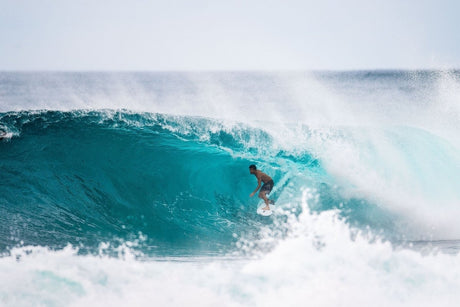The beautiful days are coming back and you feel like starting to practice skateboarding? Join the 5 million practitioners and 60,000 licensed French riders to experience new sensations! A popular sport since 1950, its inclusion in the Olympic disciplines in August 2016 only strengthened its already strong image worldwide. Returning at the Tokyo Olympics and at the upcoming Paris 2024 Olympics, it's time to start practicing to fully understand and experience this iconic sport that never gets old!
Why is the choice of skateboard important for beginners?
It is important not to overlook the choice of the first skateboard for several reasons:- A poorly suited skateboard can make learning difficult, even discouraging for the most novice riders.
- The choice of components: deck, wheels, trucks, bearings can have a significant impact on the rider's performance and comfort. For example, wheels that are too hard make the board unstable and harder to control, while trucks that are too tight or too loose make the board more difficult to maneuver.
- Safety: An ill-suited or poor-quality board can present risks of breakage or falls that may cause injuries of varying severity!
These 3 important points highlight the importance of choosing the right skateboard for a beginner. Indeed, these elements can negatively affect learning, comfort, and safety for novice riders!
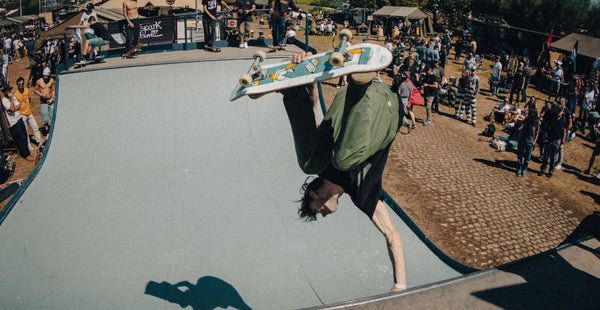
The different types of skateboard
COMPLETE SKATEBOARDS VS. SKATEBOARDS TO ASSEMBLE YOURSELF
Complete skateboards are sold with all necessary components, assembled and ready to use. This usually includes a deck, trucks, wheels, bearings, and a grip tape. These skates are popular with beginners because they are ready to use right away and therefore very practical! The complete skateboard is also ideal for parents who want to give their children a first skateboard.
On the other hand, DIY skateboards require you to buy and assemble all the components individually. The assembly therefore includes, as mentioned earlier, a deck, trucks, wheels, bearings, and a grip tape. Although assembling your own board may seem intimidating, it can be an excellent way to advance to the next level. The skateboarder can thus customize their skate according to their preferences. Additionally, the selection of decks and wheels is always impressive! Overall, complete skateboards are more convenient for beginners, while DIY skateboards are better suited for skaters who already have experience and want to customize their skateboard according to their needs.
SKATEBOARD SHAPES AND SIZES
There are several shapes and sizes of skateboard suited to specific riding styles. Here are some of the most common skateboard shapes and sizes:- Standard size skateboards: They usually measure between 7.5 and 8.5 inches wide and between 31 and 32.5 inches long. These types of skateboards are suitable for most styles and will facilitate practice and progression for beginner skaters.
- Wider skateboards: These are skateboards that measure more than 8.5 inches wide. Ideal for skating ramps and bowls as they offer a more stable platform as well as better grip. This type of skateboard is also suitable for people with wider feet.
- Shorter skateboards or street: Shorter skateboards generally measure less than 31 inches long. These skates are recommended for performing technical tricks as they are easier to handle and turn.
THE DIFFERENT PARTS OF THE SKATEBOARD
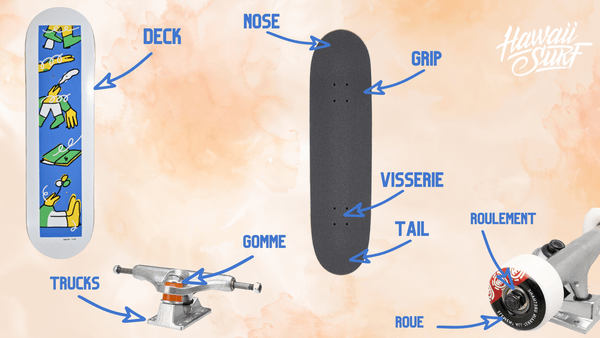
Important selection criteria for beginners
THE SIZE OF THE SKATEBOARD
The size of a skateboard depends on several factors, including: the height, weight, and the type of ride desired. Generally, beginner skaters will choose a standard size skateboard that measures between 7.5 and 8 inches wide and between 31 and 32.5 inches long. These dimensions offer a good platform to be comfortable when learning tricks. Wider skateboards measuring more than 8.5 inches wide are perfect for skating ramps and bowls with a stable and grippy deck. It is also essential to consider the person's size and weight. Indeed, larger and heavier people will choose wider and longer decks prioritizing comfort and stability.
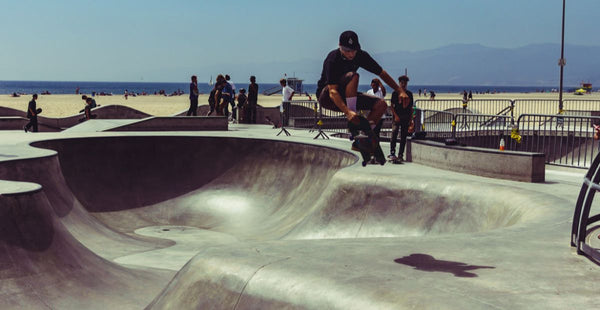
THE HARDNESS AND SIZE OF THE WHEELS
The hardness and size of the wheels can affect the performance and maneuverability of the board. For beginner skaters, it is recommended to choose wheels of standard size and hardness. This allows for better progression and more comfort. Regarding wheel size, they generally measure between 50 and 55mm in diameter. Smaller wheels are lighter and offer better maneuverability to seek the first sensations of tricks. Meanwhile, larger wheels provide a smoother and more stable ride on rougher surfaces. Finally, concerning wheel hardness, they are rated on a hardness scale called the "durometer". Standard skateboard wheels have a hardness of 99A, offering a good combination of speed, durability, and versatility for most skaters.
The harder wheels (101A and up) are designed for smooth surfaces like concrete or wood. While the softer wheels (95A or less) offer better grip combined with a smoother ride on rougher surfaces like asphalt.
In general, for beginner skaters, it is better to choose standard size wheels (50-55mm in diameter), with standard hardness (99A) for a simpler and more comfortable experience!
LES TRUCKS
- Low trucks offer real stability and are recommended for street and park skaters who perform tricks and slides.
- Mid trucks offer a good combination of stability and maneuverability, ideal for skaters of all levels.
- High trucks offer a greater range of motion for ramp and bowl skaters.
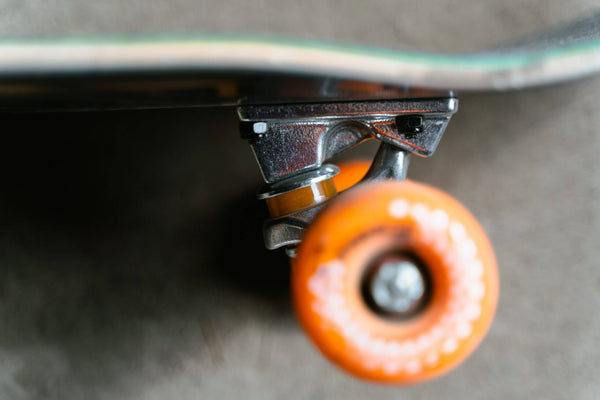
THE CONCAVE OF THE PLATEAU
For beginner skaters, it is recommended to choose a medium concave for an optimal experience. There are different types of concaves:- Soft concave (low), flatter board surface. Ideal for beginner skaters looking for a more stable and easy-to-control board.
- Medium concave (mid), the most common form of concave that ensures excellent stability and maneuverability for skaters.
- High concave, more pronounced curve, recommended for ramp and bowl skaters who need better grip and more board control.
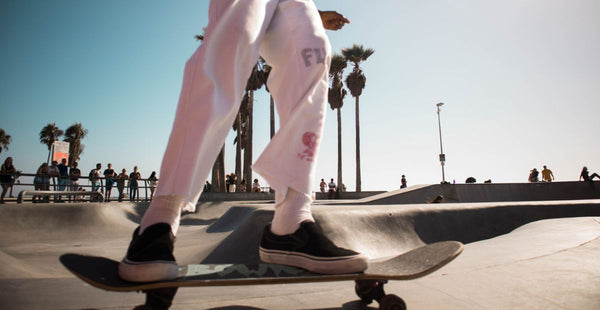
So, convinced? If you are a beginner skateboarder, know that practicing skateboarding can be difficult at first. But it is also especially very rewarding and fun once you start mastering the basics!
Our tips to not get discouraged :)
Here are some encouragements to help you in your learning journey:- Do not be discouraged by falls and failures. Skateboarding is an activity that requires practice, and you will eventually succeed if you keep training and persevering.
- Find friends to skate with. Skating with others can be a source of motivation and inspiration to improve yourself.
- Don't be afraid to try new tricks and step out of your comfort zone. Skateboarding is an activity that allows you to express your creativity and individuality.
- Make sure you have the appropriate protective gear to avoid injuries. Wear a helmet, knee pads, elbow pads, and wrist guards to protect yourself during falls.
- Have fun! Skateboarding is a fun activity and you should not forget to enjoy it and not belittle the progress you are making.
We will meet next Friday for a new article!
Justine, HawaiiSurf.







